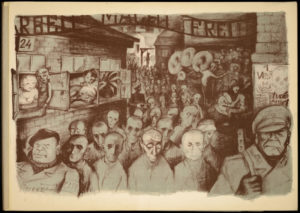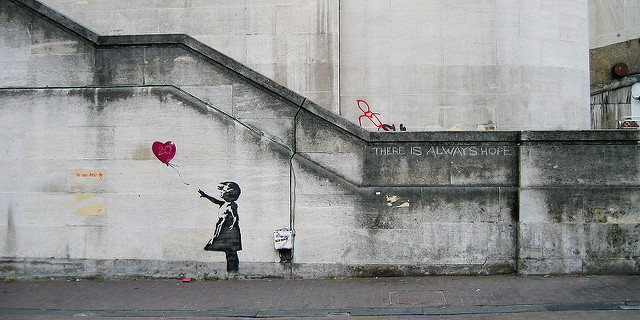Over the past few months, mankind has witnessed or personally experienced multiple tragedies and disasters. Many of these happenings were senseless and totally avoidable. This leaves all of us, victims as well as onlookers, in a state of shock and grief. We are, in a word, sorrowful. There is no cure for grief, but there is something that soothes us in the midst of the storm: art.
We Need Art in Times of Sorrow

Lithograph by Leo Haas* (1901-1983) Image via Flickr (Center for Jewish History)
In times of sorrow, people need art more than ever. Why? Because art is beauty, and beauty heals. Beauty can be a lifeline to those who are despairing. Victims of the Holocaust are prime examples of individuals who relied on beauty to get them through the impossible. In atmospheres of extreme persecution and even torture, these individuals used whatever materials they could get their hands on to create art. That art inspired something in them and their fellow prisoners that could not be stolen: hope. Author Julia Cameron expressed this sentiment well:
“(Creating) art always gives us the ability to move out of the victim position…Holocaust victims scratched butterflies on the walls of concentration camps. That assertive creative act spoke plainly: ‘You cannot kill my spirit.’ At its core, art is triumphant.”
Art Cries, “Everything Will Be Alright!”
Sometimes, a piece of art doesn’t communicate an intricate, grandiose idea or message. Very often, art simply whispers to us that everything will be alright. This is why people adorn their homes, especially rooms that they spend the most time in, with images that inspire or soothe them. It is unarguable that art really does soothe the troubled soul.
Why Art Makes Us Feel Better
There is no denying that viewing art (murals, sculptures, paintings, etc.) makes us feel better. However, making art can be even more therapeutic, giving us an outlet to express our emotions when words fail us. British magazine Psychologies published an article titled Why painting and art can make you happy that explained how making art lowers cortisol, the stress hormone that skyrockets during times of sorrow and trauma. Additionally, the Huffington Post stated,
“…new research — and a new public television documentary — make a strong case that engagement with music, dance, and other arts may be just as powerful for preserving mental health and acuity throughout our lives.”
Both viewing and making art is essential to our well-being, especially when tragedy strikes.
As Julia Cameron said, art is triumphant, a preserver of the human spirit. At this socially and politically volatile moment in time, we all need access to a little more art. We need beauty, we need hope, we need strength and nurturance and soothing. Thankfully, art offers each and every one of us all of those things.
What piece or type of art most inspires and strengthens you?
* Leo Haas was a Holocaust artist who survived Theresienstadt and Auschwitz.
Read more Segmation blog posts about art:
Do Vision Boards Really Work? (And How to Make One.)
2 Art Festivals You Can’t Miss in August 2017
Be an Artist in 2 minutes with Segmation SegPlay® PC (see more details here)
SegPlay® Mobile available for Amazon Fire, iPhone, iPad, Android




